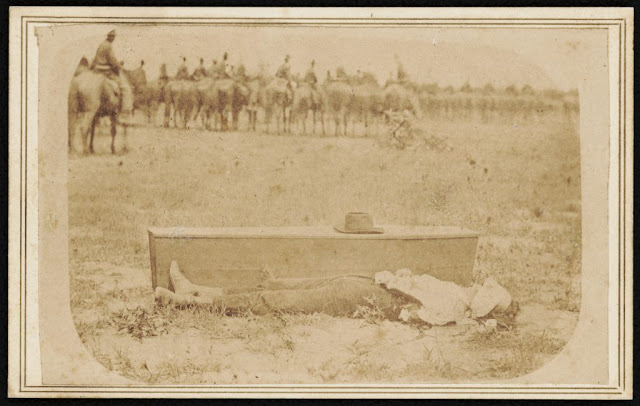A Galvanized Yankee Executed at Tullahoma
At 3 o’clock on the afternoon of Friday, January 30, 1863, twelve men from the 1st Louisiana Regular Infantry executed William C. Ackerman in Tullahoma, Tennessee. The man had been captured in the opening moments of the Battle of Stones River nearly a month earlier wearing the blue uniform of a private soldier in the 32nd Indiana Infantry. This constituted the crime that led to his execution: Ackerman had deserted from the ranks of the 1st Louisiana while the regiment was in Kentucky during Bragg’s fall offensive and joined up with the Indiana regiment while it was refitting in Louisville.
Ackerman,
a 24-year-old German native, had enlisted in Co. E of the 1st
Louisiana Regulars during the spring of 1861, among the hundreds of laborers
from New Orleans who joined up in this regiment for three years’ service,
unusual among early Confederate regiments. The 1st Louisiana first
saw service at Pensacola on the Florida coast, serving in Braxton Bragg’s
command and manning the heavy artillery batteries that guarded the harbor. In
March 1862, it entrained for Corinth, Mississippi where it joined Albert Sidney
Johnston’s Army of Mississippi and took part in the Battle of Shiloh as part of
General Adley H. Gladden’s brigade. It accompanied General Bragg and his army on
the offensive into Kentucky and it was at Lancaster, Kentucky in late September
that Ackerman deserted the regiment. Crossing over to Federal lines, on October
1st he enlisted with a German unit, the 32nd Indiana, at
Louisville and was assigned to Co. C.
Three months later, the 32nd Indiana took part in the Stones River campaign, the regiment taking its position on the far right of the Federal army on the evening of December 30th. The 32nd Indiana was among the first Federal regiments hit by General McCown’s flank attack on the morning of December 31st and it was here that Private Ackerman was captured. He was marched into the center of Murfreesboro, spending the night on the grounds of the Rutherford County courthouse along with thousands of other Federal prisoners.
“The prisoners were paroled as fast as they were
brought to Murfreesboro, and Ackerman was duly paroled with the others,” a
reporter noted. “But on Friday morning, General Bragg directed that 300 of the
paroled Federal prisoners be sent to the battlefield to bury the Federal dead.
About 1,200 prisoners were on the cars for Chattanooga, and the 300 were taken
from this number and sent to the field. Shortly after arriving on the field,
some of the 1st Louisiana recognized Ackerman and pointed him out to
an officer, who ordered him to be returned to the provost marshal’s office in
Chattanooga. He was afterwards identified by officers and men of his former
regiment, and he was placed in close confinement.”
Ackerman
was sent to Tullahoma when the Confederates left Murfreesboro and was sentenced
by a general court martial to execution. A reporter for the Chattanooga
Daily Rebel witnessed the event and wrote the following about what he witnessed.
At 3 o’clock, the firing detail of twelve men were drawn up before the provost guardhouse and the prisoner was brought out and seated on his coffin on a wagon, guarded by eight men and proceeded to the execution ground, the drum and fife playing the solemn notes of the dead march. Arriving at the ground, the prisoners was conveyed to the stake before which the 1st Louisiana Infantry was drawn up in line of battle and was securely tied thereto. The firing detail was marched to within 12 paces of the prisoner. The proceedings and sentence of the Court were then read by the adjutant of the regiment, after which the prisoner said, “Good-bye boys.” The order was then given- ready-aim-fire. Four bullets entered the body of the prisoner, his head fell to the left side and gradually settled on his breast. He was killed instantly, his last words uttered were “take good aim,” uttered at the word “aim,” another second and he was launched into eternity. He died bravely, refusing to have his eyes bandaged and standing firm and motionless.
He was a native of Germany, about 25 years old, five feet seven
inches tall. His body was placed in the coffin and carried off for burial. The
detail that had but a few moments before marched to the air of the “Dead March”
returned to camp with the quick step to the tune of “Dixie.”
Source:
“Letter from Tullahoma,” Chattanooga
Daily Gazette (Tennessee), February 3, 1863, pg. 1











I really like your blog, I just added it to my favorites and I plan to share this article on social networks. Good continuation, News20e.
ReplyDelete